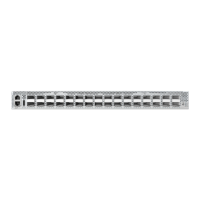C
HAPTER
1
| Introduction
Description of Software Features
– 63 –
EQUAL-COST
MULTIPATH LOAD
BALANCING
When multiple paths to the same destination and with the same path cost
are found in the routing table, the Equal-cost Multipath (ECMP) algorithm
first checks if the cost is lower than that of any other routing entries. If the
cost is the lowest in the table, the switch will use up to eight paths having
the lowest path cost to balance traffic forwarded to the destination. ECMP
uses either equal-cost unicast multipaths manually configured in the static
routing table, or equal-cost multipaths dynamically detected by the Open
Shortest Path Algorithm (OSPF). In other words, it uses either static or
OSPF entries, not both.
ROUTER REDUNDANCY The Virtual Router Redundancy Protocol (VRRP) uses a virtual IP address to
support a primary router and multiple backup routers. The backups can be
configured to take over the workload if the master fails or to load share the
traffic. The primary goal of this protocol is to allow a host device which has
been configured with a fixed gateway to maintain network connectivity in
case the primary gateway goes down.
ADDRESS RESOLUTION
PROTOCOL
The switch uses ARP and Proxy ARP to convert between IP addresses and
MAC (hardware) addresses. This switch supports conventional ARP, which
locates the MAC address corresponding to a given IP address. This allows
the switch to use IP addresses for routing decisions and the corresponding
MAC addresses to forward packets from one hop to the next. Either static
or dynamic entries can be configured in the ARP cache.
Proxy ARP allows hosts that do not support routing to determine the MAC
address of a device on another network or subnet. When a host sends an
ARP request for a remote network, the switch checks to see if it has the
best route. If it does, it sends its own MAC address to the host. The host
then sends traffic for the remote destination via the switch, which uses its
own routing table to reach the destination on the other network.
MULTICAST FILTERING Specific multicast traffic can be assigned to its own VLAN to ensure that it
does not interfere with normal network traffic and to guarantee real-time
delivery by setting the required priority level for the designated VLAN. The
switch uses IGMP Snooping and Query at Layer 2 and IGMP at Layer 3 to
manage multicast group registration. It also supports Multicast VLAN
Registration (MVR) which allows common multicast traffic, such as
television channels, to be transmitted across a single network-wide
multicast VLAN shared by hosts residing in other standard or private VLAN
groups, while preserving security and data isolation for normal traffic.
MULTICAST ROUTING Routing for multicast packets is supported by the Protocol-Independent
Multicasting - Dense Mode and Sparse Mode (PIM-DM, PIM-SM) protocols.
These protocols work in conjunction with IGMP to filter and route multicast
traffic. PIM is a very simple protocol that uses the routing table of the
unicast routing protocol enabled on an interface. Dense Mode is designed
for areas where the probability of multicast clients is relatively high, and

